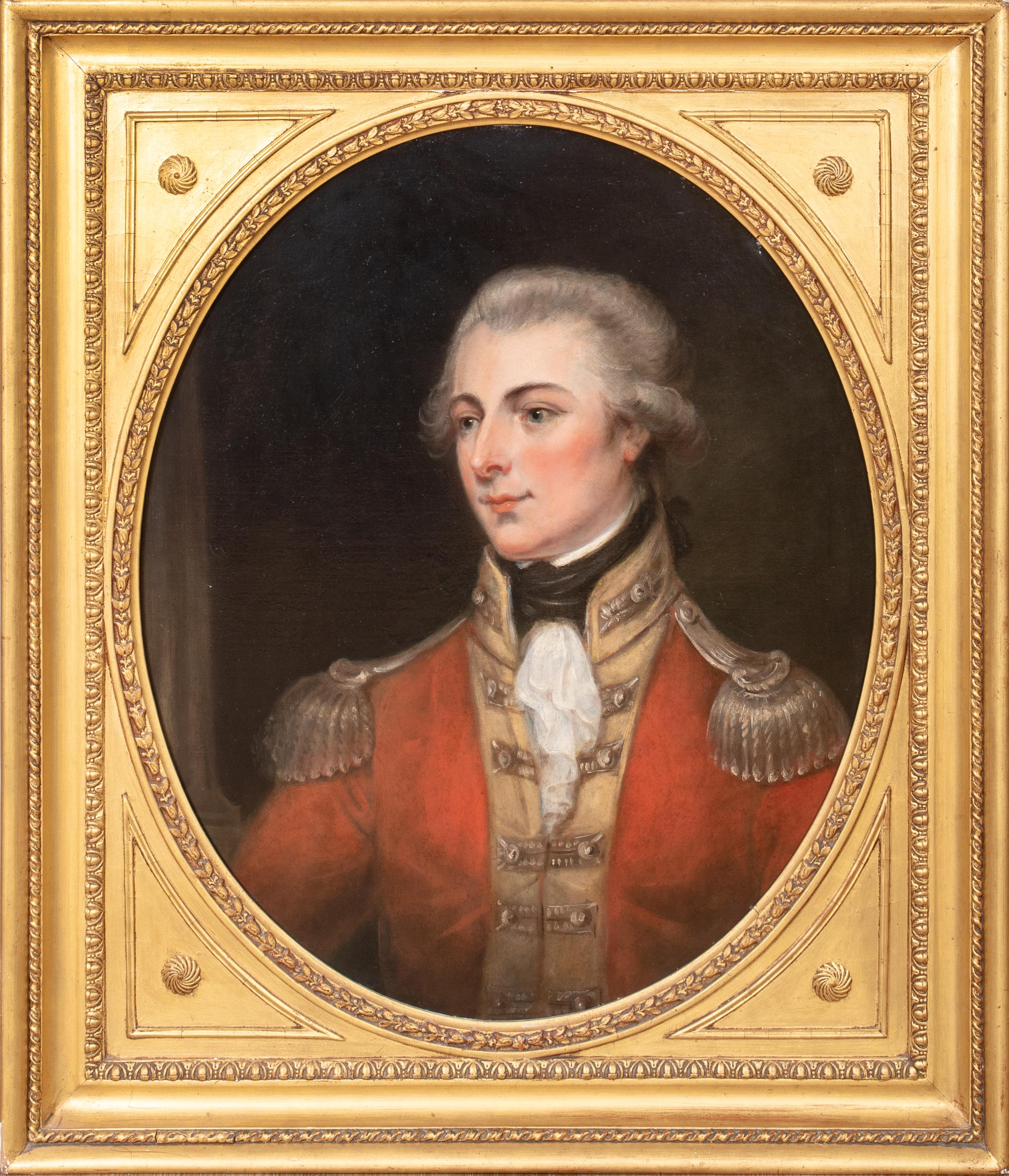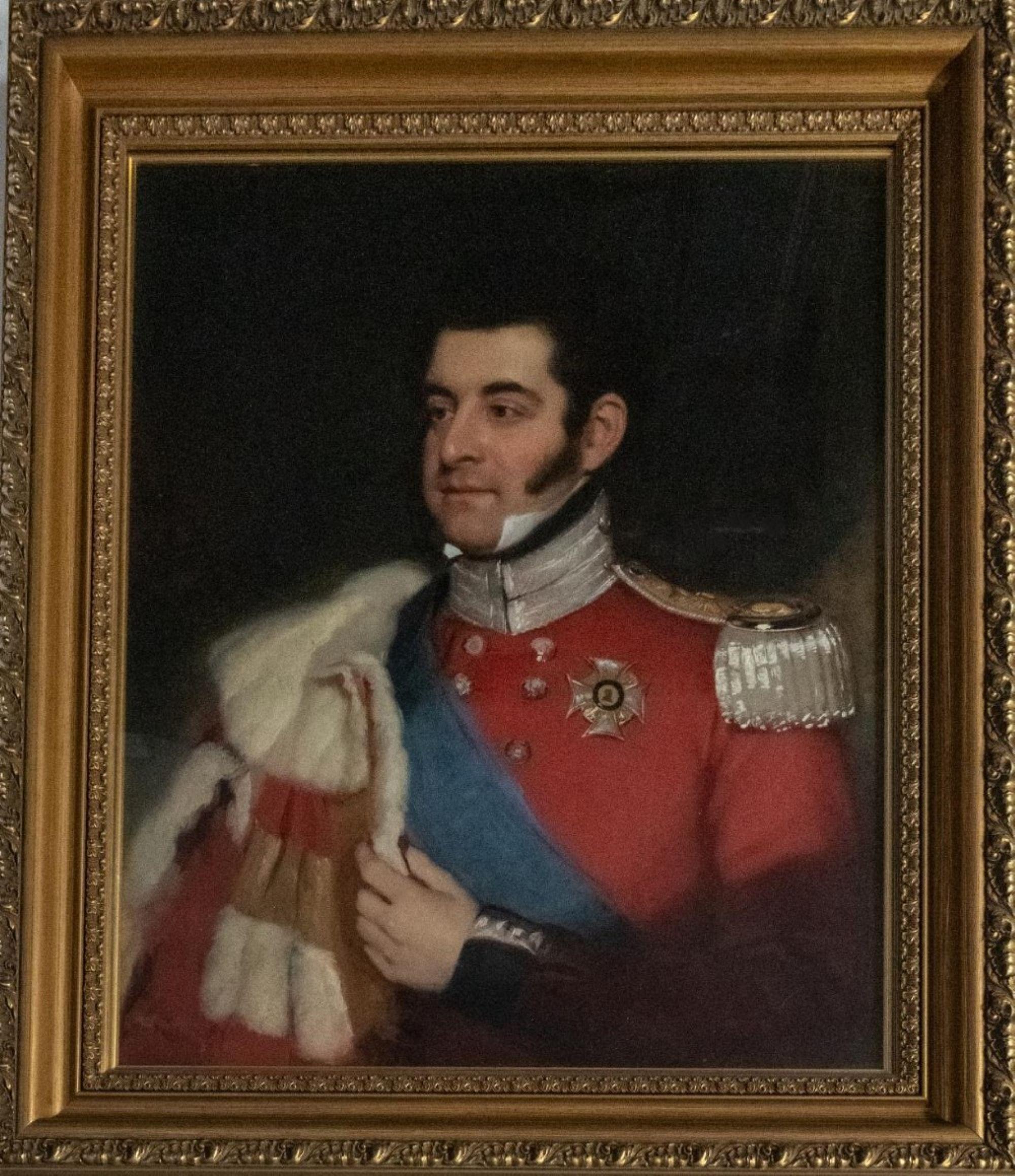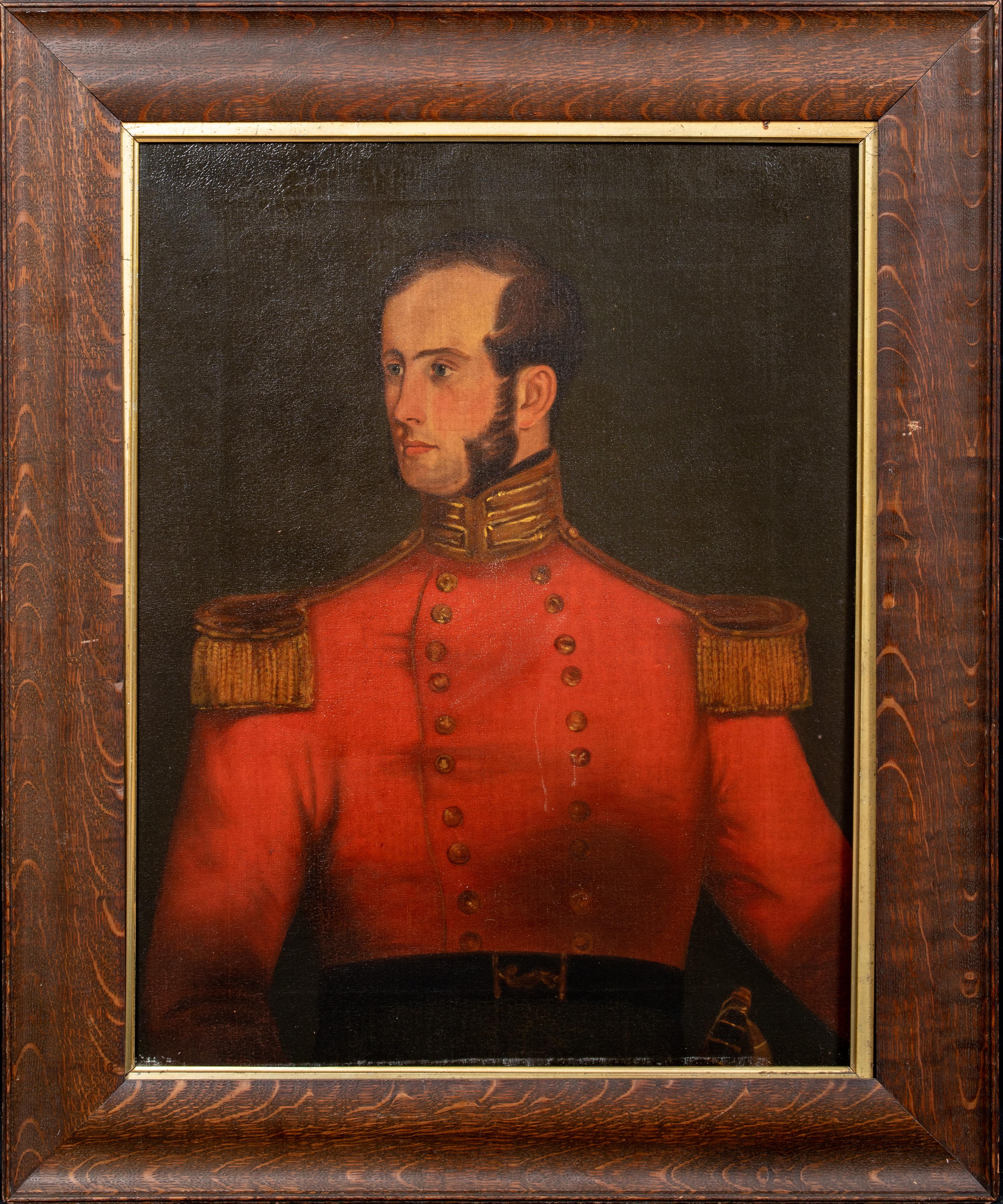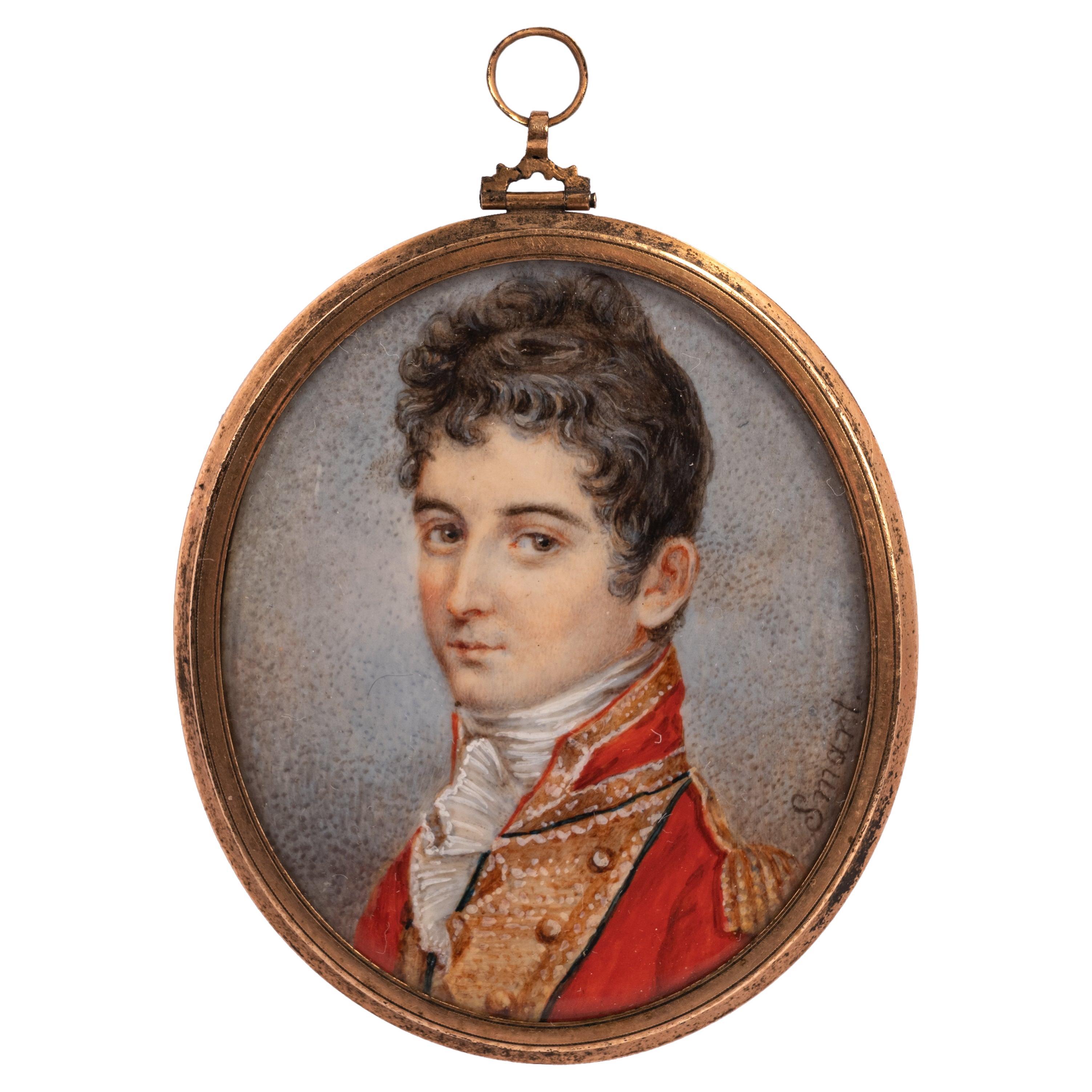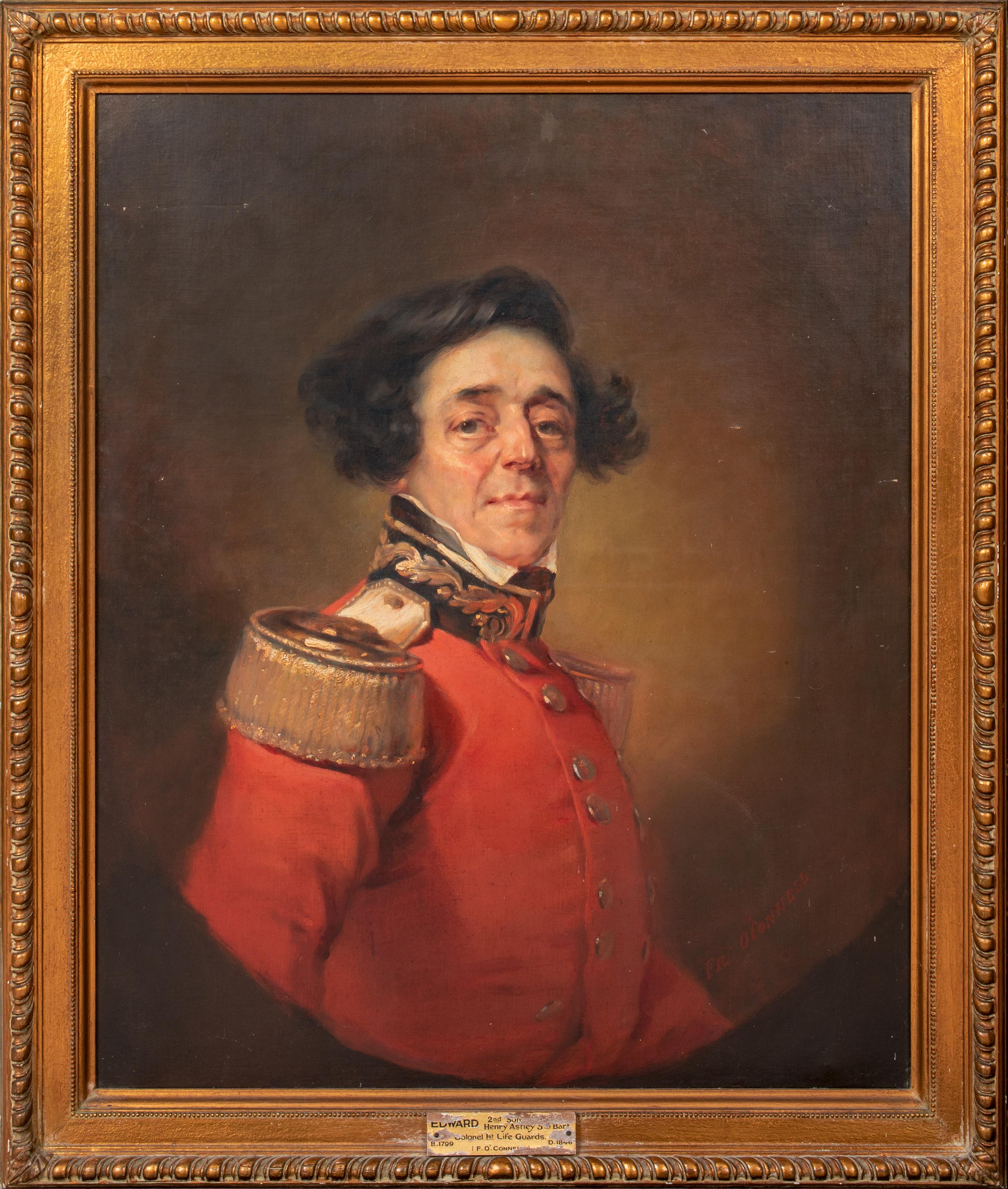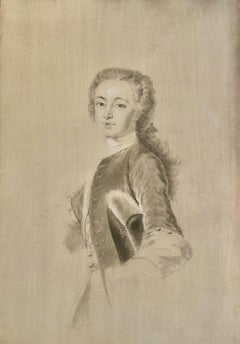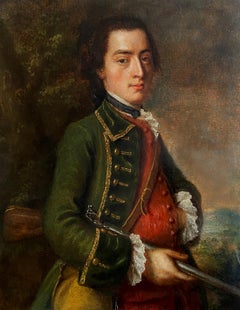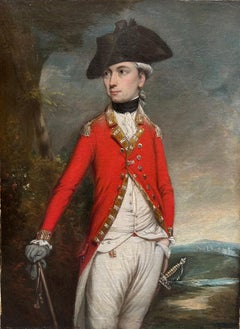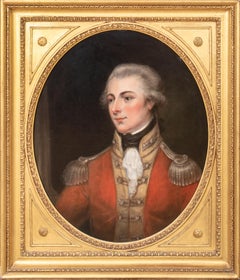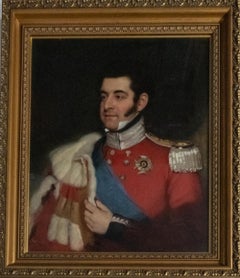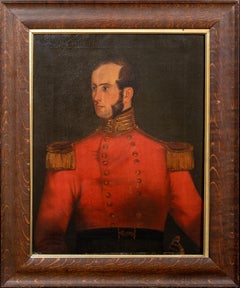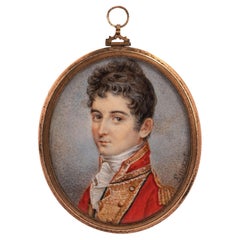Items Similar to Portrait of a Young Officer, Thomas Lawrence, Irish Volunteers
Want more images or videos?
Request additional images or videos from the seller
1 of 4
Sir Thomas LawrencePortrait of a Young Officer, Thomas Lawrence, Irish Volunteers1783
1783
$9,955.89
£7,200
€8,482.48
CA$13,794.38
A$14,969
CHF 7,932.25
MX$183,587.56
NOK 98,161.07
SEK 92,757.01
DKK 63,325.91
About the Item
Sir Thomas Lawrence PRA
1769-1830
Portrait of a Young Officer
Pastel with touches of black chalk on paper
Signed and inscribed on an old label verso: "Be pleased to keep away / from the Damp & from dust / T Lawrence AE 13. / 1783."
Wash mount and gilt frame
Provenance
W.E. Spooner;
Anonymous sale, Phillips London, 17 April 2000 lot 196
Sothebys, Old Master & Early British Paintings, 14 April 2011 • London Lot 246
Old label verso describes how this was drawn in 1783 at the age of 14!
This is a portrait of an officer from the Irish Volunteers. The Irish Volunteers was a part-time military force raised by local initiative in Ireland in 1778. Their original purpose was to guard against invasion and to preserve law and order at a time when British soldiers were withdrawn from Ireland to fight abroad during the American Revolutionary War.
As a young boy Thomas Lawrence lived with his parents who ran a coaching inn near Bath. Clearly talented from this young age, he drew the passing travellers who stopped at the inn and this soldier may have been one such sitter. Lawrence was only 13 years old when he drew this work. To capitalise upon their son's talents, the family later moved to Bath and sent Lawrence to London in 1787 where he entered the Royal Academy schools at the earliest possible age. Works from such an early period of Lawrence's creativity are rarely to be found today.
This rare early portrait drawn in Bath shows the level of technical skill that Lawrence had reached at 14 years old. His use of colour and tone to depict flesh and all the subtle variations in the texture and pigmentation of his sitter’s face, powdered hair and clothes show how Lawrence conceived pastel as a form of painting and partly explains how he could have made the smooth transition to oil painting so soon afterwards.
When he arrived in Bath from Devizes in 1780, eleven-year-old Thomas Lawrence (1769–1830) was promoted as a natural-born genius like his Renaissance predecessor Raphael. The local press announced the arrival of the boy wonder and his ‘Striking Sketches’, inviting the ‘Nobility and Gentry’ to sit for their portraits.
Thomas Lawrence was a prodigious portraitist from the age of just eight, when he began to draw his first portraits in pencil. His father, a mildly reprobate innkeeper also called Thomas, exploited his son’s self-taught talent for capturing likenesses, and much of Lawrence’s childhood was spent producing small head and shoulder portraits. Little is known about this aspect of the Young Lawrence’s work, but he was clearly talented enough to justify a substantial clientele. Guests at his father’s inn near Bath could have their portrait done by a celebrated local prodigy, hailed as a Mozart of art, and early sitters included the young William Pitt [Private Collection, formerly with Philip Mould Ltd]. Following his father’s bankruptcy in 1780, the family moved to Bath, and relied almost entirely on the portrait commissions of Thomas junior.
It was amongst the large network of Bath’s wealthy connoisseurs that Lawrence first came into contact with the Old Masters, primarily through drawings and prints. We know, for example, that he made copies in pastel of Old Masters, such as Raphael’s Transfiguration (Sothebys, London, 12th March 1987) and Carracci’s Mars (Sothebys, London, 25th February 1998). Most of Lawrence’s early pastel portraits pre-Bath are simple profile likenesses – but by the mid 1780s he was able to attempt more challenging compositions.
- Creator:Sir Thomas Lawrence (1769 - 1830, British)
- Creation Year:1783
- Dimensions:Height: 10.75 in (27.31 cm)Width: 9 in (22.86 cm)
- More Editions & Sizes:1 of 1Price: $9,956
- Medium:
- Movement & Style:
- Period:1780-1789
- Condition:
- Gallery Location:London, GB
- Reference Number:1stDibs: LU52410986782
About the Seller
5.0
Vetted Professional Seller
Every seller passes strict standards for authenticity and reliability
Established in 2007
1stDibs seller since 2014
82 sales on 1stDibs
Typical response time: 3 hours
- ShippingRetrieving quote...Shipping from: London, United Kingdom
- Return Policy
Authenticity Guarantee
In the unlikely event there’s an issue with an item’s authenticity, contact us within 1 year for a full refund. DetailsMoney-Back Guarantee
If your item is not as described, is damaged in transit, or does not arrive, contact us within 7 days for a full refund. Details24-Hour Cancellation
You have a 24-hour grace period in which to reconsider your purchase, with no questions asked.Vetted Professional Sellers
Our world-class sellers must adhere to strict standards for service and quality, maintaining the integrity of our listings.Price-Match Guarantee
If you find that a seller listed the same item for a lower price elsewhere, we’ll match it.Trusted Global Delivery
Our best-in-class carrier network provides specialized shipping options worldwide, including custom delivery.More From This Seller
View AllPortrait of William Henry Kerr, Earl of Ancram, 4th Marquess of Lothian
Located in London, GB
James Fellowes
Flourished 1719 - 1750
Portrait of William Henry Kerr, Earl of Ancram, 4th Marquess of Lothian
Oil on canvas, signed & dated 1747
Image size: 29 1/2 x 24 1/2 inches (75 x 62 cm)
Original gilt wood frame
William Henry Kerr was born a member of the Scottish peerage to William, third Marquess of Lothian, and his first wife Margaret, daughter of Sir Thomas Nicholson of Kemnay, first Baronet. William was styled Master Jedburgh until 1722, when his father was elevated to a Marquessate, after which he was referred to as Lord Jedburgh until 1735. Following his father’s military footsteps, on 20 June 1735 Ancram was commissioned as a cornet to the regiment (11th Dragoons) of his grand-uncle, Lord Mark Kerr. Ancram married Lady Caroline...
Category
1740s Old Masters Portrait Paintings
Materials
Oil
Portrait of a Young Duke, 19th Century French Chalk Drawing
Located in London, GB
Black chalk, white smudge and highlights, on paper
Image size: 10 3/4 x 5 3/4 inches (27.25 x 14.5 cm)
A half-length portrait of a young Duke wearing a long wig...
Category
19th Century Portrait Drawings and Watercolors
Materials
Chalk
Portrait of a Man with a Rifle
Located in London, GB
Oil on layered paper
Image size: 10 1/2 x 8 1/4 inches (26.5 x 21 cm)
Contemporary swept frame
This is an eighteenth century portrait of a...
Category
Late 18th Century Naturalistic Figurative Paintings
Materials
Oil, Laid Paper
Portrait of Captain George Meek
Located in London, GB
William Roth
Born 1754
Portrait of Captain George Meek
Oil on canvas, signed & dated 1782 lower right
Image size: 25 x 18 ½ inches (64 x 47 cm)
Provenance
Murray Cassy
Jean Piere O...
Category
Late 18th Century Portrait Paintings
Materials
Canvas, Oil
Armand Emmanuel du Plessis, 5th Duke of Richelieu
Located in London, GB
Oil on canvas
Image size: 10 x 7 1/2 inches (25.5 x 19 cm)
Contemporary gilt frame
This painting is a copy of Thomas Lawrence’s 1822 portrait of Armand Emmanuel du Plessis, Duke of ...
Category
19th Century English School Portrait Paintings
Materials
Oil, Canvas
Portrait of a King's Messenger, 18th Century English Artist, Original Frame
By Charles Philips
Located in London, GB
Charles Philips
1703 - 1747
Portrait of a King's Messenger
Oil on canvas
Image size: 35 ¾ x 28 inches
Original gilt frame
King's Messenger
The job of a King's Messenger was that of a diplomatic courier, hand-carrying important and secret documents around the world. Some say that the history of the sovereigns' messengers goes back to 1199, but the first known messenger was John Norman, who in 1485 earned 4d (1½ pence) per day for carrying the state papers of Richard III.
The silver greyhound on the messenger's badge dates back to Charles II. In 1660, during his exile at Breda, Netherlands, Charles II issued a declaration of amnesty to all those who had opposed him and his father. He used messengers to make his intentions known. In answer to the messenger's question "How will they know me?", Charles reached forward to a silver bowl on the table in front of him. This bowl, with four decorative greyhounds standing proud above the rim, was well known to all courtiers. Charles broke off a greyhound and gave it to the messenger as a guarantee that the message came from him. From that date, the King's Messenger always wore a silver greyhound around his neck.
Later, dating from George II or III, a badge with the Royal Arms in enamel, with the greyhound suspended beneath, was worn. A George III example of the King's Messenger Badge, pre 1800, sold for over £30,000 pounds some years ago.
The silver greyhounds were minted for each new reign, except the brief one of King Edward VIII. The sovereign's messengers were originally controlled by the Lord Chamberlain, being Messengers of the Great Chamber. When the Foreign Office was created in 1782, the messengers remained common to the three Secretaries of State.
Charles Philips was an English artist known for painting a number of portraits and conversation pieces for noble and Royal patrons in the mid-eighteenth century.
Philips was baptised in the combined parish of St Mildred, Poultry with St Mary...
Category
18th Century Portrait Paintings
Materials
Canvas, Oil
You May Also Like
Portrait Of Colonel George Gun, Gunsborough Union, 18th Century Irish
By Sir John Hoppner
Located in Blackwater, GB
Portrait Of Colonel George Gun, Gunsborough Union, 18th Century
School of John HOPPNER (1758-1810)
Large circa 1782 Irish military portrait of Colonel George Gun, of the Gunsboroug...
Category
18th Century Portrait Paintings
Materials
Canvas, Oil
19th century portrait military officer 5th Royal Lancashire Militia, East Lancs
Located in York, GB
A fine 19th century oil on canvas portrait stated to be Captain Paul John Henry Butler, 5th Royal Lancashire Militia, half length, wearing breast star. Hou...
Category
19th Century Realist Portrait Paintings
Materials
Oil
Portrait Of A British Officer, early 19th Century - Napoleonic Wars Era
Located in Blackwater, GB
Portrait Of A British Officer, early 19th Century
Napoleonic wars Era
Early 19th Century Napoleonic Wars Era portrait of a British military officer, oil on canvas. Excellent quality and condition portrait of the officer in his red tunic...
Category
Early 19th Century Portrait Paintings
Materials
Canvas, Oil
Antique Miniature Young Man Military Officer Portrait Painting John Smart, 1780
Located in Portland, OR
A fine antique miniature portrait painting, John Smart (1741-1811). The painting circa 1780.
A very handsome portrait miniature of a young military officer...
Category
Antique 1780s English Georgian Paintings
Materials
Brass
Portrait Colonel Edward Astley 1st Royal Life Guards, 19th Century
Located in Blackwater, GB
Portrait Colonel Edward Astley 1st Royal Life Guards, 19th Century
by Frederique Emile O'Connell (1823-1885)
Large 19th Century Portrait of Colonel Edward Astley, 1st Royal Life Gua...
Category
19th Century Portrait Paintings
Materials
Canvas, Oil
Portrait of a Seated Gentleman - British 19th century art portrait oil painting
By Thomas Lawrence (circle)
Located in Hagley, England
This striking British 19th century portrait oil painting is attributed to the circle of Sir Thomas Lawrence. Painted circa 1820 it is the portrait of a seated gentleman in a brown hi...
Category
Early 19th Century Realist Portrait Paintings
Materials
Oil
More Ways To Browse
Portrait Of A Young Boy
Small Portraits
The Antique Inn
Revolutionary War Antique
Drew Young
Officer Portrait
Portraits Of Officers
Britains Soldiers
Sir Thomas Lawrence
American Revolutionary War
Antique Oil Painting Ireland
Oil Portrait Officer
Oil Portrait Irish
Oil Painting And Sir
Adventure Time
Marjorie And Marjorie
1889 Portrait Drawing
Homoerotic Art
